In conversation with alum Alexandra Grant
Alexandra Grant (MFA Painting & Drawing 2000) describes the influences and ambitions at the core of her artistic practice, from the performance of language in her paintings to her philanthropic work with the grantLOVE project.
Q. Hi, Alexandra. During a recent artist talk, you said you wanted to paint like a reader. When did you first discover this, and what does painting like a reader mean?
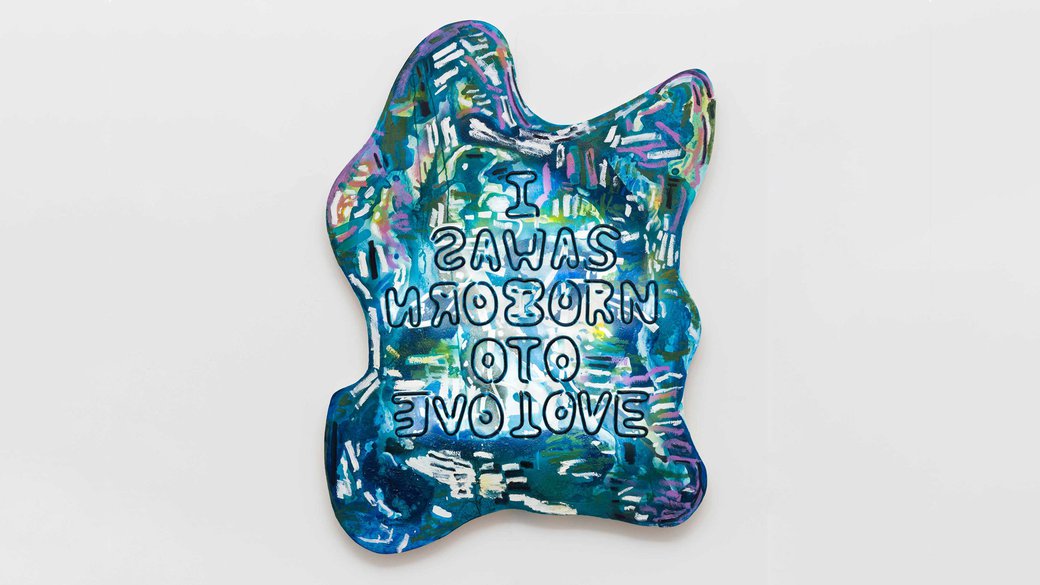
Alexandra Grant, I was born to love (2), 2019. Neon, acrylic, and oil paint on shaped wood. Courtesy of the artist.
A. In Hélène Cixous’s essay “The Last Painting or Portrait of God” she writes: “I would like to write like a painter. I would like to write like painting.” This idea, of writing, like painting, as a “bird-catcher of instants,” was an enormous provocation to my imagination as a young artist. (I had her essay republished in my first museum show catalog, curated by Alma Ruiz at the Museum of Contemporary Art, Los Angeles, in 2007.) I wanted to paint like a writer! But what did this mean? I found every way I could to make Hélène’s ideas visual. Cut to 12 years later in my career, giving a talk as a visiting artist at the Vermont Studio Center, and my words that “I want to paint like a reader.”
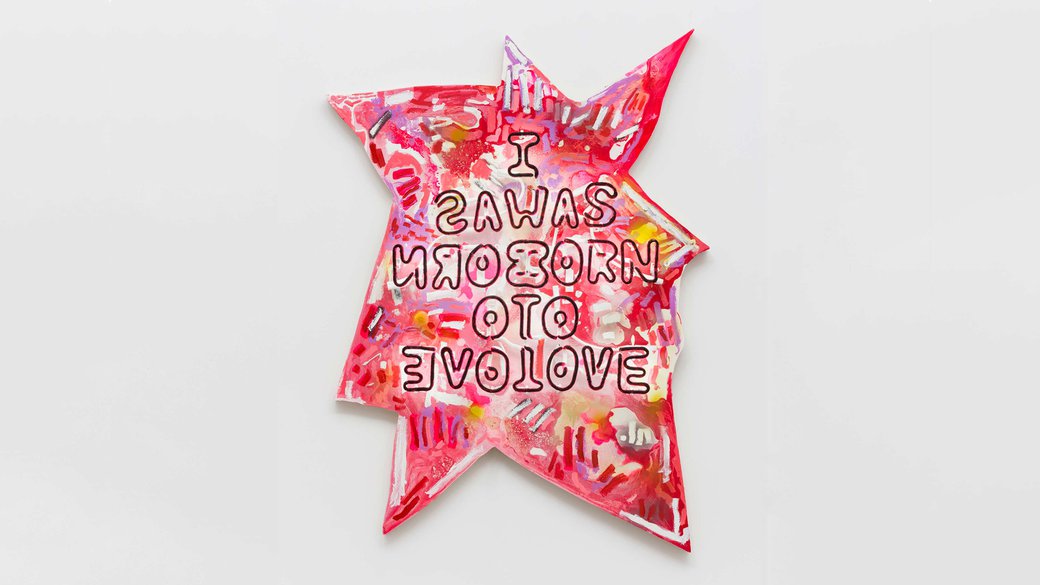
Alexandra Grant, I was born to love (1), 2019. Neon, acrylic, and oil paint on shaped wood. Courtesy of the artist.
Literature has been my main interest or subject matter since I started my career as an artist. At first I was very orthodox about my systems: The words painted needed to be embodied; no illustration, no techniques from the world of advertising. But as so happens after years of work, I came up to the limit of the very rules and parameters that first inspired my practice. I realized that I couldn’t paint like a writer, because it was a writer’s metaphor about painting. But that I could paint like a reader, based on my emotional experience of reading text. If I was painting from a poem and it made me saddened to read it, I wanted to be able to incorporate that sadness. If angered, to show that emotion visually in my aggressive brushstrokes or enraged sense of color. A reader does much more than just receive the information in texts, she responds to them.
Q. Who are some novelists, cartoonists, playwrights, or poets writing like painters? Any point in history is fair game.
A. You already know that Hélène Cixous writes like a painter. Her work continues to take my breath away in how she breaks conventions and gives permission the reader didn’t even know she was looking for. For someone new to her work, I would recommend Three Steps on the Ladder of Writing.
What painting does differently than writing and any other media is that it conflates time and space. Books, movies, music, are all linear in how they are received. In a painting, one takes in the image all at once, and then begins to decode the order of things, what happened before what. Paintings are true oneiric time-spaces, where things that couldn’t be coextant in reality are. And painters can lie about time, pretending that a late brushstroke happened early, and so on. So, for me, your question becomes, what writers bend language to become nonlinear dream spaces? My goodness! Clarice Lispector, of course, the hypertext pioneer Michael Joyce, the poet Denise Newman, the painter and writer Etel Adnan, Jesse Ball, Julio Cortázar.
What painting does differently than writing and any other media is that it conflates time and space.”
Q. Your work has taken inspiration from literature, such as the Greek tragedy Antigone. How is a myth-based story like and unlike a painting?
A. I’ve been working with the myth of Antigone for many years now in part because of the question of her continued relevance. Why has her story endured and mattered to so many people, generation after generation? Why has every generation reinvented Antigone for their times? The same questions can be asked of painting. Painting, like myth, is essential to human survival. It’s a form of storytelling as mark-making that is so primal; we’ve been putting our fingerprints on the wall since prehistory. I am here now.
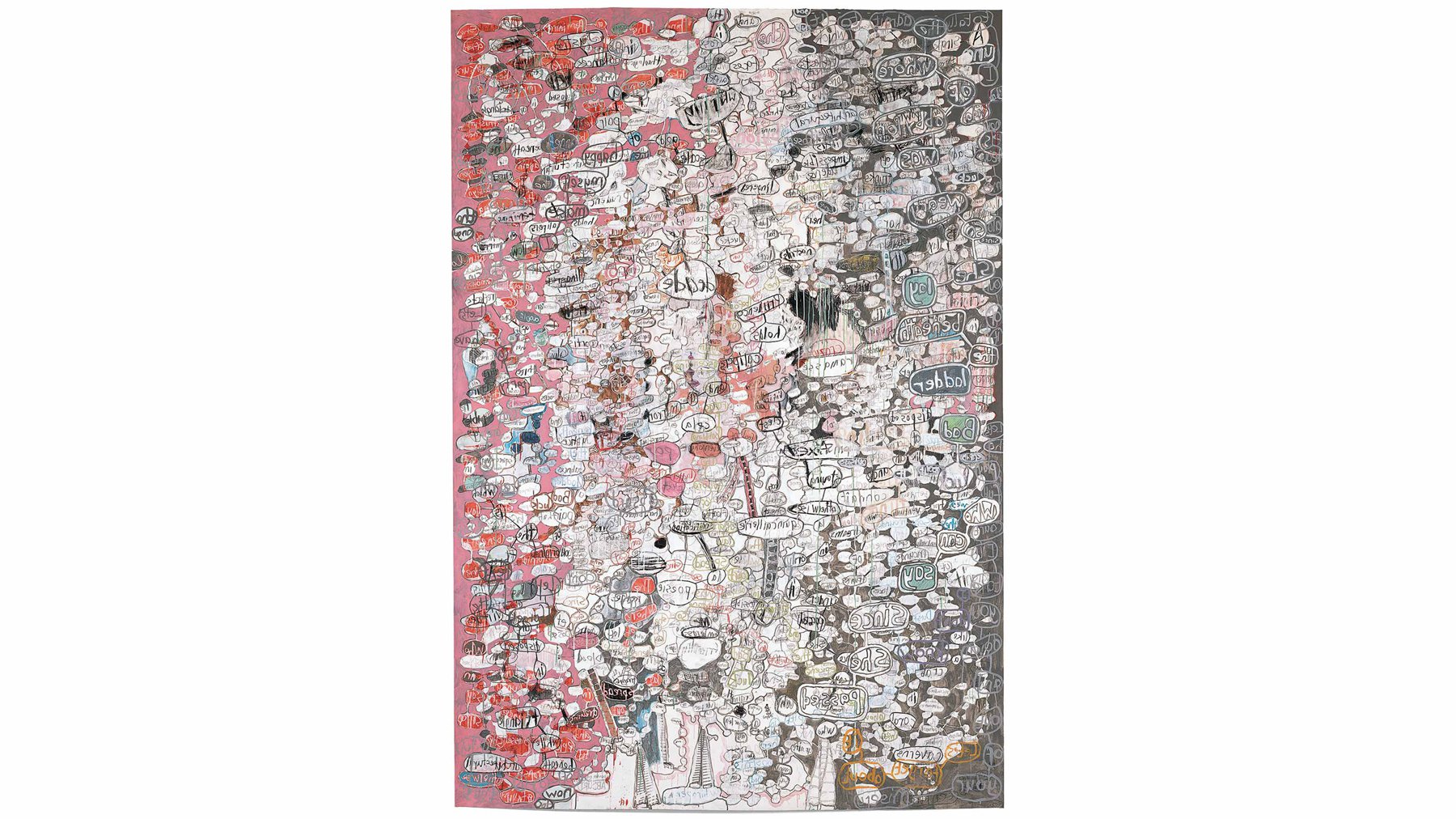
Alexandra Grant, she taking her space (after Michael Joyce’s poem “he taking the space of,” 2004), 2004. Mixed media on paper, 120 x 80 inches. The Museum of Contemporary Art, Los Angeles. Courtesy of the artist.
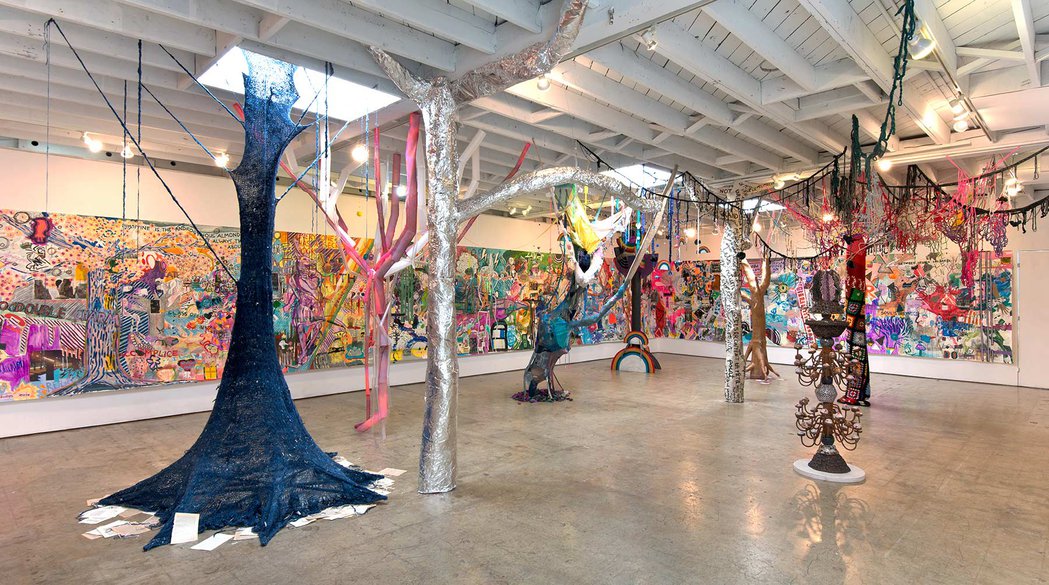
Alexandra Grant, Forêt Intérieure/Interior Forest (installation view, 18th Street Arts Center, Los Angeles), 2013. Courtesy of the artist. Photo by Brian Forrest.
Q. How did you work with the subject matter of literature during your time at CCA? I would love to learn about some of those formative experiences.
A. The biggest-picture question I asked myself as a graduate student … well, let me back up. While at CCA, I couldn’t help but watch the whole ecosystem of art as presented in the late 1990s with a bit of distance, a bit like an anthropologist ... or what in old French is forestier, an outsider or stranger … literally a forest-dweller. It was my first exposure to a professional, in the economic sense, approach to art … and I noticed that students, and even some faculty were asking questions about career … My questions were more along the lines of, “What am I doing here?” “Why don’t I care as much about some of the things my peers seem to be caring about?” “Why do my classmates seem to know what they’re doing, career-wise?” Followed by: “Why don’t I know what I’m doing, career-wise?” Forest-dweller. So the biggest-picture question I asked myself in graduate school was, “What do I care about?” “What will I care about in the long term?” And: “What will I care about in the long term, when no one is looking, and when everyone is looking?”
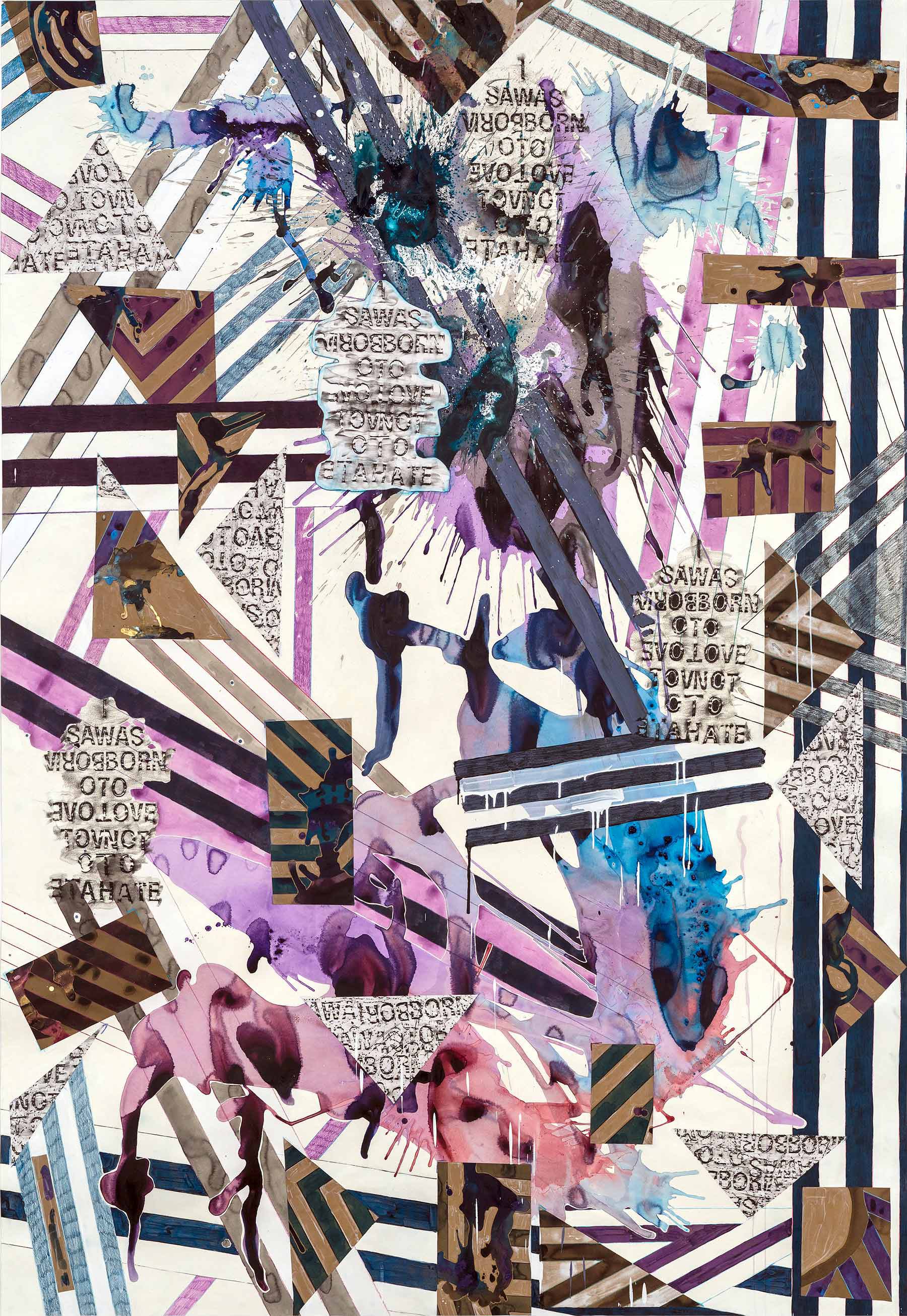
Alexandra Grant, Antigone 3000 (2), from the series Antigone 3000, 2018. Collage, wax rubbing, acrylic paint and ink, sumi ink, and colored pencil on paper. Courtesy of the artist.
“What will I care about in the long term, when no one is looking, and when everyone is looking?”
(MFA Painting & Drawing 2000)
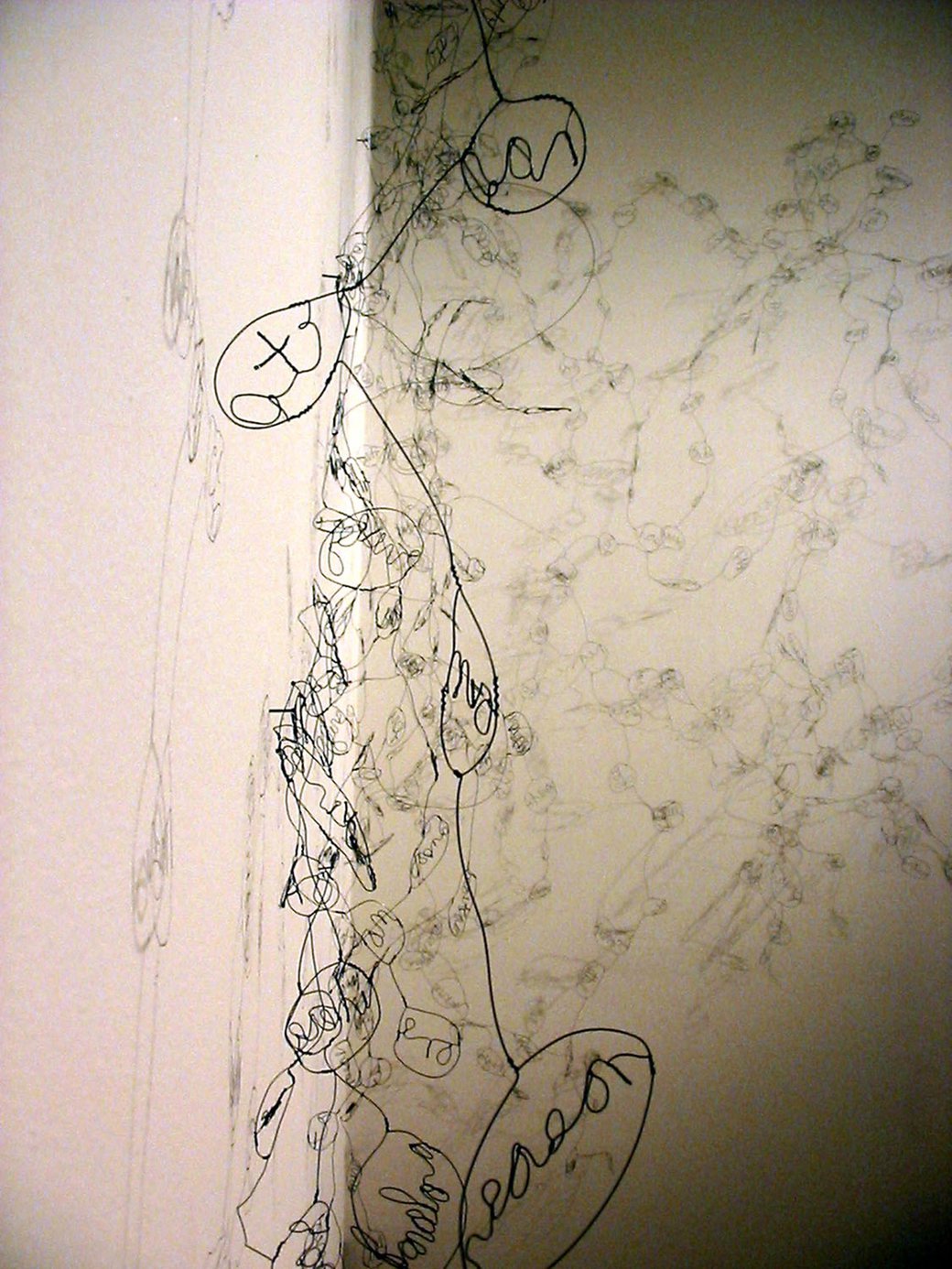
Alexandra Grant, drawings without paper (after Wisława Szymborska’s poem “Possibilities”) (installation view, Brewery Project, Los Angeles), 2002. Wire, shadow, and pencil. Courtesy of the artist.
And the answer to those questions, then, as now, is reading. I’ve always loved to read. So, as a tender graduate student, I decided that I would put reading and the love of literature at the heart of my practice as an artist.
I was fortunate to have been wooed to CCA by Stephen Goldstine, and when I explained where I was in my thinking, he encouraged me to work with the playwright John O’Keefe as a mentor. John taught me a lot about the challenges and inner-landscapes of a living writer. And I worked in the studio with poets Pablo Neruda and Wisława Szymborska, unbeknownst to them. Two of the poems I mapped most frequently in my drawings and paintings were Neruda’s “El gran verano,” from Cantos ceremoniales, and "Possibilities" by Szymborska.
Q. What’s a word, phrase, or quote that’s been on your mind lately? I’ve been thinking about “parthenogenesis” and “camber.”
A. I love the word petrichor! First, how cool that some Australian researchers made up a word! When I learned it, I realized I too had been searching for a way to describe the smell after a first rain. And now the word alone transports me to that meteorological, sensual moment.
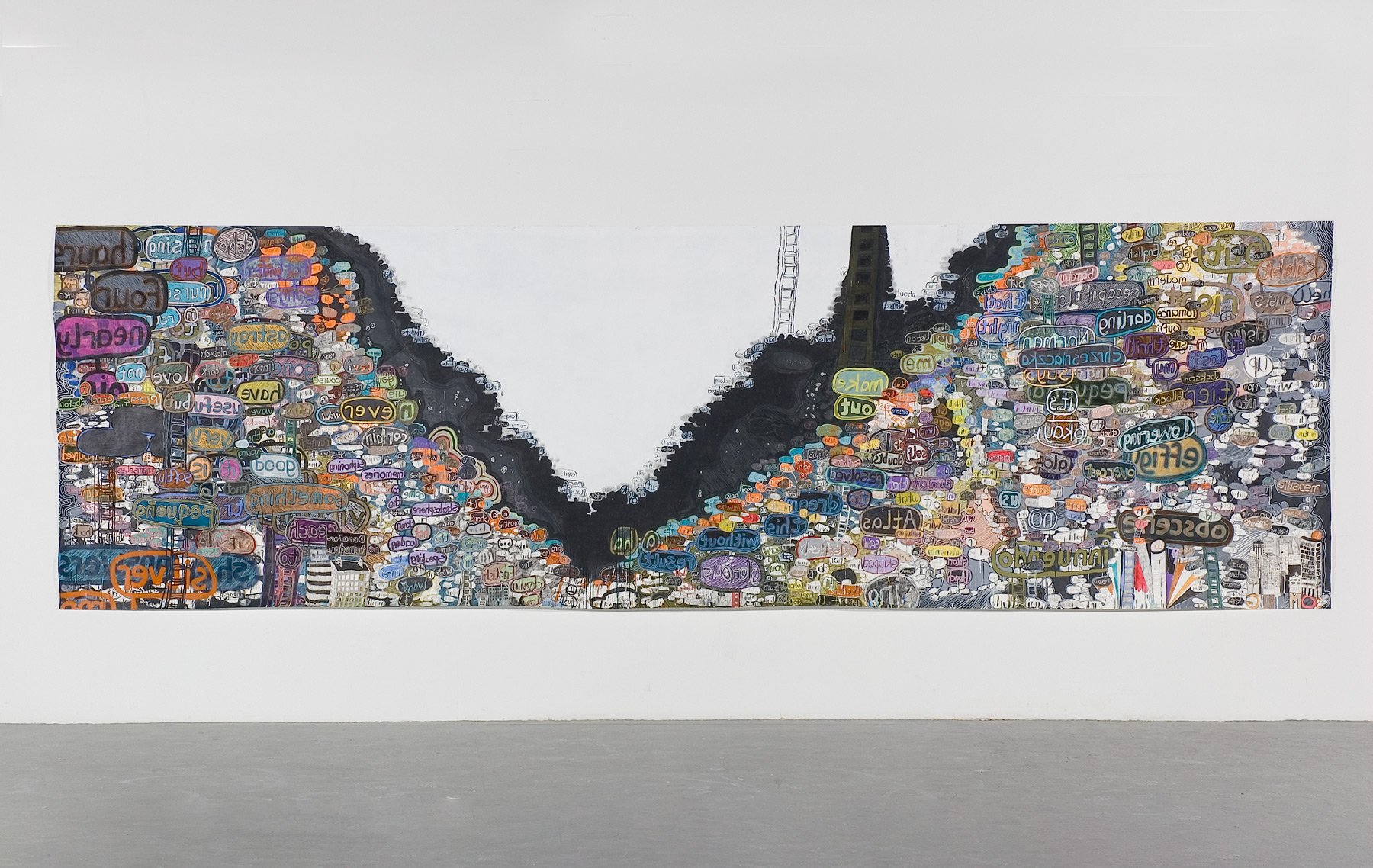
Alexandra Grant, babel (installation view, after Michael Joyce’s poem “Was,” 2006), 2006. Mixed media on paper, 80 x 264 inches. Courtesy of the artist.
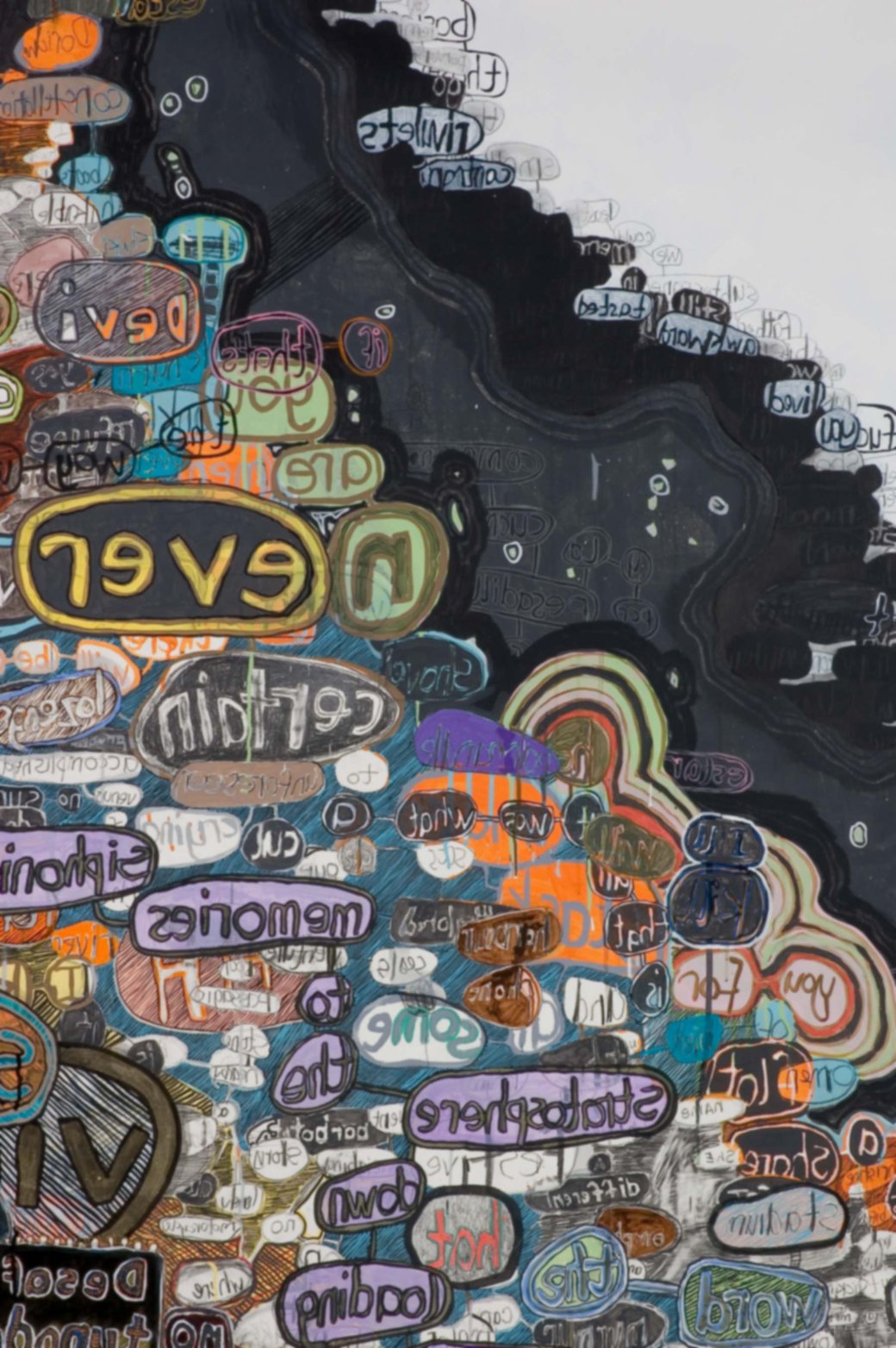
Alexandra Grant, babel (detail), 2006. Courtesy of the artist.
Q. What does your collaboration process with living writers look and feel like? I’m thinking about your collaboration with Michael Joyce. I’m curious to know how involved writers are in the selection of language for the paintings.
A. I’ve worked with so many different writers over the years—from this exchange to my process in the studio to those whose work we’ve published at X Artists’ Books to having my own writing transformed by Eve Wood in The Artists’ Prison. Fundamental to each collaboration is transparency as to what is going to happen to the text—how will it be presented, contextualized, and possibly transformed.
After working with Neruda (deceased) and Szymborska (too shy to reach out to her) in graduate school, I began the search for a writer who would like to exchange in the here and now. This process was harder than I had imagined … as several writers I approached asked, “How will I be recognized?” “How will I make money from this?” Or expressed that they didn’t want their writing to be changed. I realized that I wanted to find a writer who was open to a visual artist transforming their writing, and possibly showing them something about themselves that they hadn’t expected but perhaps they secretly hoped for.
I found Michael’s writing accidentally, while on vacation in Mexico at an internet cafe, curating a show … I Googled the word “domesticity,” which led me to a page of his iconic text Reach. After reading one paragraph, I knew I had to work with this writer. I didn’t know who they were and so traced the paragraph back through its hypertext form to the University of Iowa website and found Michael’s email. My first email was, “Dear Mr. Joyce…” He allowed me to use Reach in one of my early mapping pieces, shown at Solway Jones Gallery in Los Angeles, 2004, where I placed each word in a bubble and made long, DNA-like strands of language in wire, shadow, and drawing. Michael sent me an image he had made of boxes he had put around his words in Microsoft Word, and it was clear, he had imagined someone mapping his words even before I found his text online.
From that moment on we developed a methodology that I would share what I was working on and he would write a text or series of texts based on the idea. Then I would use these as a score or a script with which to begin the painting. But I was painting as a reader, and in so doing, the text would be interpreted, transformed. If I liked a phrase, I could repeat it. If I had a negative response, I could strike a sentence out in paint or paint it over. But even if it was erased, the words were still there. That’s the quiddity of painting—that even when something is painted over, it is still there materially. (This is a tangent, but in Anne Lamott’s Bird by Bird she writes about painters being able to white out a painting—impossible! Layers and layers of oil paint will make a healthy brown. You really can only delete in Microsoft Word.)
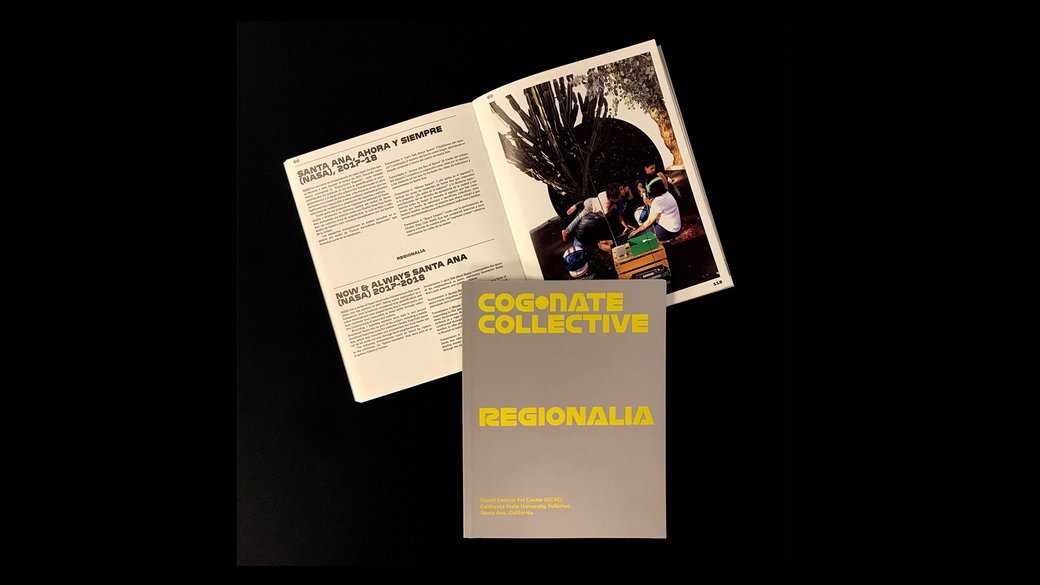
Regionalia, a recent X Artists’ Books publication (co-published with Grand Central Arts Center).
Q. Artist books invite collaboration. How do you hope readers encounter and engage with the books you and Keanu Reeves release into the world through X Artists’ Books?
A. X Artists’ Books came from the real need I had to find a publisher for The Artists’ Prison and subsequently discovering that Keanu Reeves—my collaborator on artists’ books Ode to Happiness and Shadows—had been nurturing a project by Benoît Fougeirol called (Zus), and the graphic designer I asked to design The Artists’ Prison, Jessica Fleischmann, had a secret book she had been making for years with playwright Sylvan Oswald, High Winds. To answer your question, I hope that readers know they are encountering “secret books” filled with intimate hopes and dreams. This returns to my point of view as a forestier, or outsider. I hope our books fill readers with the sense that they have encountered someone daring to ask the question, “What do I care about when no one is looking, and when everyone is looking?” I think our readers are as curious as our artists, and I’m very grateful to them.
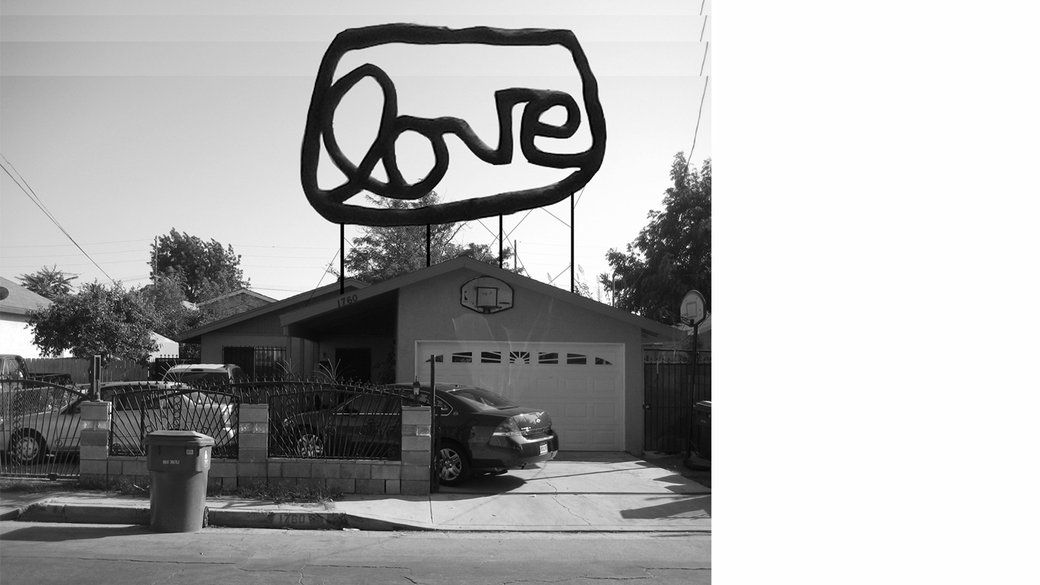
The Love House in Watts, Los Angeles, 2009.
Q. Can you tell me about one of the arts nonprofits that has or currently benefits from the grantLOVE project? Perhaps one that is near and dear to your heart?
A. Yes! In 2019, the grantLOVE project worked with three wonderful nonprofits, but there were many more that I wanted to benefit! They were:
Heart of Los Angeles (HOLA) Visual Arts
Run by the inspiring Nara Hernandez, this after-school arts program works in my Los Angeles neighborhood—MacArthur Park. All HOLA Visual Arts program participants graduate from high school! And HOLA supports emerging artists to be teaching artists for the young students. I believe that arts education is a civil rights issue because it’s empowering young people from underserved neighborhoods and schools to be creative and problem-solve.
X-TRA Contemporary Arts Journal
Artist-run, X-TRA is Los Angeles’ oldest arts magazine. Fundamental to a thriving arts community is discourse—from reviews to artists’ projects to manifestos—and X-TRA provides this safe space for possibility for our community.
The Love House, fiscally sponsored by Fulcrum Arts.
Learn more about the Love House
The Love House originated in Watts, Los Angeles, with a unique artist-driven proposal. In 2008, Alexandra Grant was invited by the Watts House Project to collaborate with a local Watts family on a functional and creative housing renovation plan. Grant proposed transforming the Moneik Johnson family home—across the street from the iconic Watts Towers—into a “living artwork,” blending private and public spaces and bringing architects, artists, designers, and residents together in creative partnership. They called the re-imagined home the Love House. Through her grantLOVE project, which is also artist-owned and operated, Grant produced and sold her LOVE trademarked jewelry to help the Johnsons raise $60,000 for the renovation.
About this interview
This interview, conducted over a span of a few months in a live Google document, has been lightly edited for length and clarity. Ellipses were naturally made marks within Grant’s responses and don't indicate an omission of text.
View stories about the power of fine arts
CCA’s community is making the world a better place


